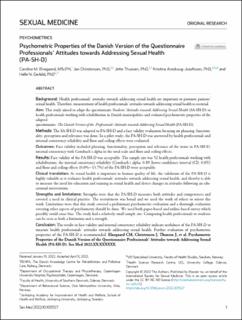| dc.contributor.author | Elnegaard, Caroline M | |
| dc.contributor.author | Christinsen, Jan | |
| dc.contributor.author | Thuesen, Jette | |
| dc.contributor.author | Josefsson, Kristina Areskoug | |
| dc.contributor.author | Gerbild, Helle | |
| dc.date.accessioned | 2023-02-17T11:37:43Z | |
| dc.date.available | 2023-02-17T11:37:43Z | |
| dc.date.created | 2022-05-18T08:47:58Z | |
| dc.date.issued | 2022 | |
| dc.identifier.citation | Sexual Medicine - Open Access. 2022, 10 (4), 1-8 | en_US |
| dc.identifier.issn | 2050-1161 | |
| dc.identifier.uri | https://hdl.handle.net/11250/3051910 | |
| dc.description | This is an open access article under the CC BY-NC-ND license http://creativecommons.org/licenses/bync-nd/4.0/) | en_US |
| dc.description.abstract | Background: Health professionals’ attitudes towards addressing sexual health are important to promote patients’ sexual health. Therefore, measurement of health professionals’attitudes towards addressing sexual health is essential.
Aim: This study aimed to adapt the questionnaire Students’ Attitudes towards Addressing Sexual Health (SA-SH-D) to health professionals working with rehabilitation in Danish municipalities and evaluated psychometric properties of the adapted questionnaire: The Danish Version of the Professionals’ Attitudes towards Addressing Sexual Health (PA-SH-D).
Methods: The SA-SH-D was adapted to PA-SH-D and a face validity evaluation focusing on phrasing, functionality, perception and relevance was done. In a pilot study, the PA-SH-D was answered by health professionals and internal consistency reliability and floor and ceiling effects were evaluated.
Outcomes: Face validity included phrasing, functionality, perception and relevance of the items in PA-SH-D, internal consistency with Cronbach’s alpha in the total scale and floor and ceiling effects.
Results: Face validity of the PA-SH-D was acceptable. The sample size was 52 health professionals working with rehabilitation, the internal consistency reliability (Cronbach’s alpha: 0.89 [lower confidence interval {CI}: 0.85]) and floor and ceiling effects (0.0%−13.7%) of the PA-SH-D were acceptable. Clinical translation: As sexual health is important in human quality of life, the validation of the PA-SH-D is highly valuable as it evaluates health professionals’ attitudes towards addressing sexual health, and thereby is able to measure the need for education and training in sexual health and detect changes in attitudes following an educational intervention.
Strengths and limitations: Strengths were that the PA-SH-D measures both attitudes and competences and covered a need in clinical practice. The recruitment was broad and we used the work of others to orient this work. Limitations were that this study covered a preliminary psychometric evaluation and a thorough evaluation covering other aspects of psychometry should be done. We used both paper-based and online-based survey which possibly could cause bias. The study had a relatively small sample size. Comparing health professionals to students can be seen as both a limitation and a strength.
Conclusion: The results in face validity and internal consistency reliability indicate usefulness of the PA-SH-D to measure health professionals’ attitudes towards addressing sexual health. Further evaluation of psychometric properties of the PA-SH-D is recommended. | en_US |
| dc.language.iso | eng | en_US |
| dc.publisher | Elsevier (ISSM) | en_US |
| dc.rights | Attribution-NonCommercial-NoDerivatives 4.0 Internasjonal | * |
| dc.rights.uri | http://creativecommons.org/licenses/by-nc-nd/4.0/deed.no | * |
| dc.subject | questionnaire | en_US |
| dc.subject | sexuality | en_US |
| dc.subject | rehabilitation | en_US |
| dc.subject | psychometrics | en_US |
| dc.subject | health professional | en_US |
| dc.subject | Denmark | en_US |
| dc.title | Psychometric properties of the danish version of the questionnaire professionals’ attitudes towards adressing sexual health (PA-SH-D) | en_US |
| dc.type | Peer reviewed | en_US |
| dc.type | Journal article | en_US |
| dc.description.version | publishedVersion | en_US |
| dc.rights.holder | © 2022 The Authors. Published by Elsevier Inc. on behalf of the International Society for Sexual Medicine | en_US |
| dc.source.pagenumber | 1-8 | en_US |
| dc.source.volume | 10 | en_US |
| dc.source.journal | Sexual Medicine - Open Access | en_US |
| dc.source.issue | 4 | en_US |
| dc.identifier.doi | 10.1016/j.esxm.2022.100527 | |
| dc.identifier.cristin | 2025029 | |
| cristin.ispublished | true | |
| cristin.fulltext | original | |
| cristin.qualitycode | 1 | |

